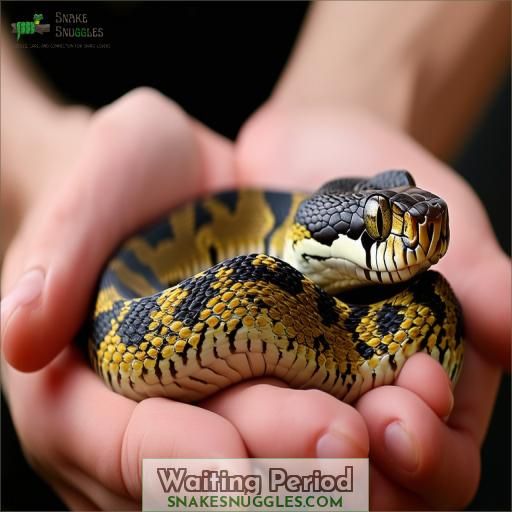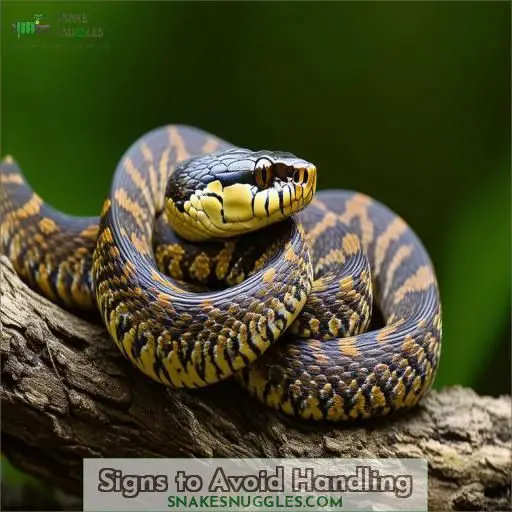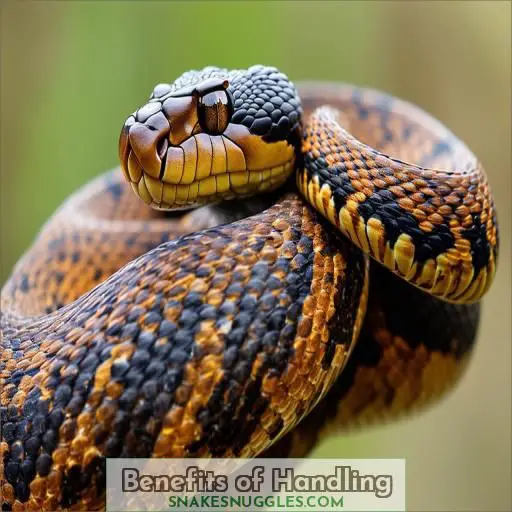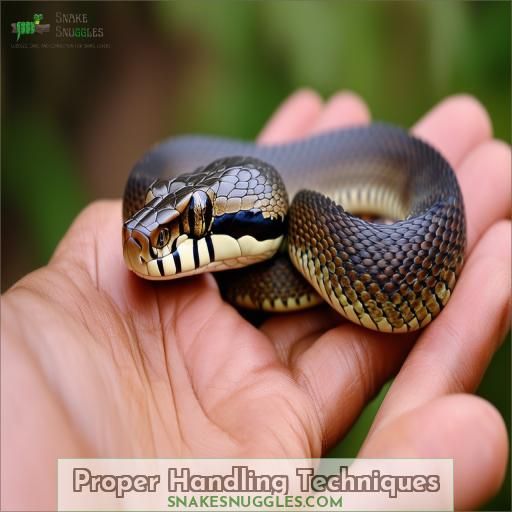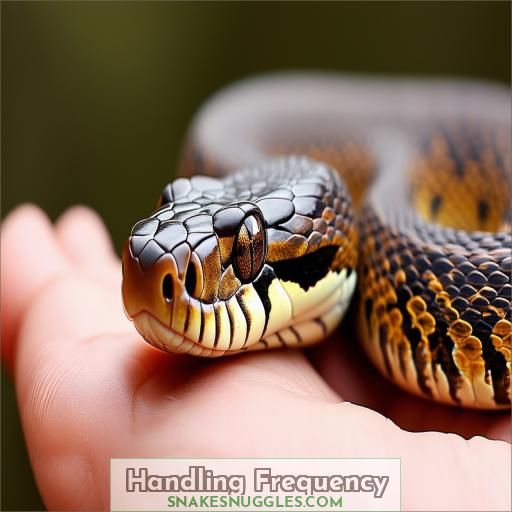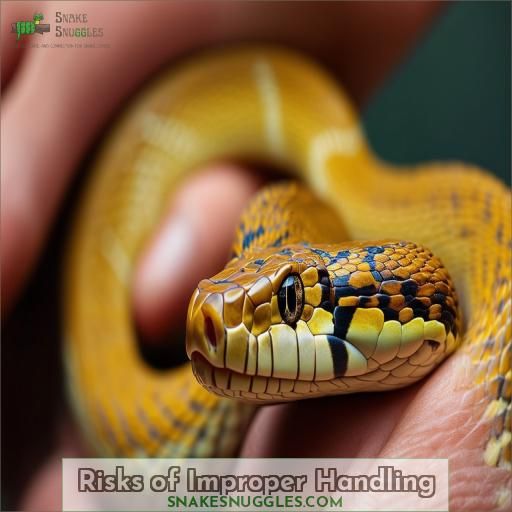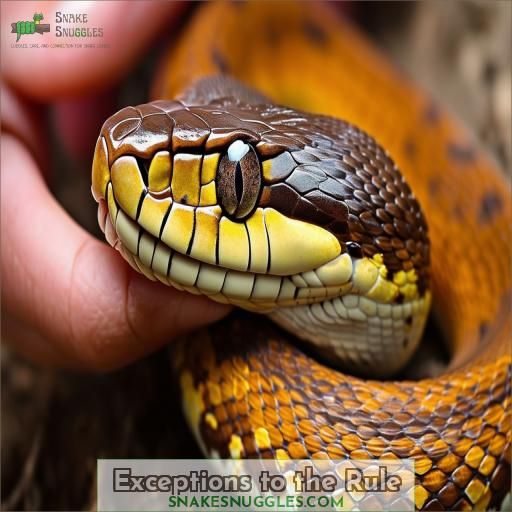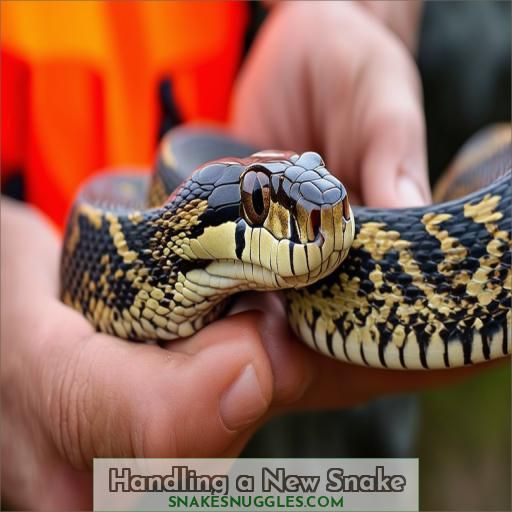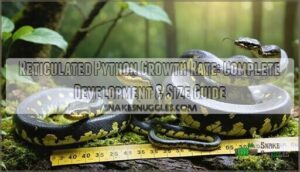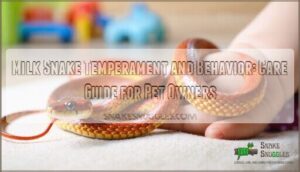This site is supported by our readers. We may earn a commission, at no cost to you, if you purchase through links.
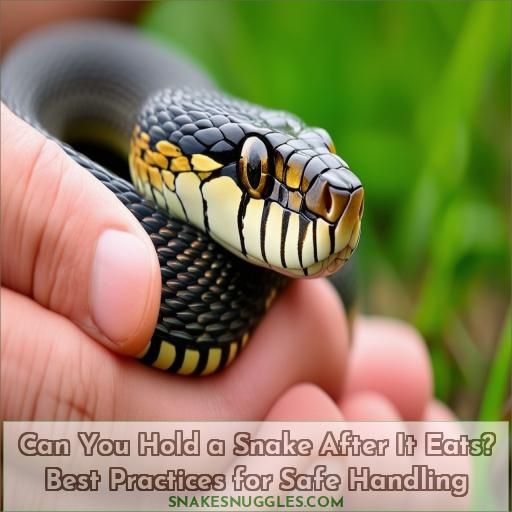 While you can hold a snake after it eats, it’s best to wait 48-72 hours for proper digestion.
While you can hold a snake after it eats, it’s best to wait 48-72 hours for proper digestion.
During this window, avoid handling to prevent defensive behaviors like coiling, hissing, or striking attempts due to regurgitation risk.
After the waiting period, gentle handling has benefits like building trust, enabling health checks, and promoting socialization.
When you do hold the snake, approach from the side, support its body fully, and avoid restricting its head.
By respecting the snake’s needs and using proper handling techniques after it eats, you’ll guarantee a stress-free, safe experience for both of you.
Want to know the ideal frequency and other best practices?
Table Of Contents
- Key Takeaways
- Can You Hold a Snake After It Eats Best Practices?
- Waiting Period
- Signs to Avoid Handling
- Benefits of Handling
- Proper Handling Techniques
- Handling Frequency
- Risks of Improper Handling
- Exceptions to the Rule
- Handling a New Snake
- Frequently Asked Questions (FAQs)
- Can you handle a snake after feeding?
- How long should I wait to hold my ball python after eating?
- Is it safe to handle a hungry snake?
- How long should I wait to hold a new snake?
- How long does it take for digestion?
- Do all snakes react the same way?
- Can snakes be trained for regular handling?
- When is it safe to feed again?
- What are the signs of a stressed snake?
- Conclusion
Key Takeaways
- Patience, grasshopper! After your snake’s meal, give it a "digestion vacation" for 48-72 hours before attempting any handling. Trust me, a rushed rendezvous could lead to an unpleasant protein spill you’ll want to avoid.
- Read the room! Tune into your snake’s body language for signs of stress or discomfort like coiling, hissing, or striking motions. If your slithery buddy seems tense, back off – forcing cuddles never ends well.
- Proper technique is key! Approach your snake from the side, support its body fully, and avoid restricting its head. Handle with care, and your reptilian pal will feel as secure as a snug bug in a rug.
- Every snake is a unique noodle! Some love regular socialization, while others prefer the "leave me be" approach. Respect your snake’s individual preferences, and you’ll build a bond stronger than a titanium trucker knot.
Can You Hold a Snake After It Eats Best Practices?
Yes, you can hold a snake after it eats, but it’s best to wait at least 48-72 hours to avoid potential risks like regurgitation or stress. Proper handling techniques and monitoring the snake’s behavior are essential for safe interaction after a meal.
Waiting Period
After your snake eats, you’ll need to avoid handling it for 48-72 hours.
This waiting period allows for proper digestion, reducing risks like regurgitation or internal damage.
The duration can vary based on factors like meal size, temperature, and your snake’s individual preferences.
For example, larger meals or cooler environments may require extended wait times.
However, in emergencies, gentle handling may be necessary.
Signs to Avoid Handling
When handling a snake after it has eaten, it’s imperative to observe its body language and behavior for signs of defensive posturing or stress. These indicators, such as coiling tightly, hissing, striking motions, or attempts to regurgitate its meal, signal that the snake isn’t ready for human interaction and should be left undisturbed to complete its digestion process. Learn more about the snake’s digestion process.
Defensive Behavior
You’ll want to avoid handling if your snake exhibits defensive posturing, escape attempts, or threat displays like tail rattling and head striking. These behaviors signal "leave me alone" and increase risks like salmonella exposure. Trust me, "can you hold a snake after it eats?" isn’t a question you want answered the hard way.
Regurgitation Risk
One sure sign you should avoid handling is regurgitation risk. If a snake regurgitates its meal, it loses valuable nutrients and faces dehydration, infection risks, and even death. Preventing this requires gentle handling and allowing adequate digestion time.
| Regurgitation Risks | Prevention Tips |
|---|---|
| Nutrient Loss | Wait 48+ Hours |
| Dehydration | Feed Outside Enclosure |
| Infection | Prioritize Snake’s Comfort |
| Death | Allow Full Digestion |
Stress Indicators
Alarming signs your snake needs space include fear or aggression, rapid breathing, hiding, and general discomfort. If exhibited, back off – attempting to handle risks heightened stress.
Benefits of Handling
Handling your snake can help build trust and allow for important health checks. By carefully socializing your snake through responsible handling, you can foster a positive relationship and closely monitor its condition.
Building Trust
Handling your snake respectfully can build trust. Why is this important? It:
- Reduces stress
- Promotes bonding
- Allows individualized interaction
- Encourages natural behaviors
- Fosters patience on both sides
Trust strengthens your relationship for life.
Health Checks
Handling allows you to perform essential physical checks and cleaning while removing stuck sheds respectfully and non-invasively, promoting your snake’s wellbeing through responsible care.
Socialization
Regular handling lets you bond with your pet snake, reducing its stress levels. It offers:
- Trust building between you and your reptile
- Decreased anxiety through positive socialization
- Strengthened rapport by familiarizing it with you
With gentle, patient handling sessions, your snake will associate your presence with security and comfort.
Proper Handling Techniques
When approaching a snake for handling, move slowly and avoid sudden motions or loud noises that may startle the reptile. Proper technique involves supporting the body with both hands, one positioned about one-third down the length and the other beneath the rear quarter, allowing the snake to slide through your hands in a smooth, controlled manner.
Approaching the Snake
| Approach the snake from the side, avoiding direct eye contact. | Wear | Gloves | Boots |
|---|---|---|---|
| For protection | Avoid scents | Quiet movements |
A side approach and protective gear help keep you and your snake calm during handling.
Picking Up Safely
Hold the snake with one hand supporting 1/3 down its body, the other securing the last quarter. Use handling gloves, protective boots, and a calm demeanor in a warm environment. Avoid sudden movements; use a snake hook to gently lift it.
Holding Position
Cradle the snake’s body in a gentle curve, arms supporting its midsection. Keep hands firm yet loose, maintaining alignment while allowing movement. Your grip provides security, not restraint. Avoid constricting or pinning the head. With proper positioning, you create a safe, comfortable hold.
Handling Frequency
When determining appropriate handling frequency for your snake, it’s essential to bear in mind the individual preferences of your pet. Some snakes may enjoy regular interaction, while others thrive with limited handling outside of their necessary shedding and feeding cycles.
Individual Preferences
Regarding handling methods and frequency, you’ll want to observe your snake’s individual preferences. Some snakes enjoy regular socialization, while others prefer minimal interaction – respecting their comfort level is key for safety precautions.
Shedding Cycles
You’ll want to avoid handling during shedding cycles, as it can:
- Increase stress
- Disrupt the shedding process
- Heighten risk of injury
- Cause the snake discomfort
Wait until the full shed is complete before considering gentle handling.
Feeding Schedule
You’ll handle less frequently after big meals or in warm temps, when digestion’s slower. Follow your snake’s cues—some prefer minimal handling around feedings, while others don’t mind. Adjust handling based on meal size, individual preferences, and shedding cycles.
Risks of Improper Handling
Improper handling after a snake has eaten can lead to injury, such as jaw misalignment or internal damage if the snake constricts itself. It also induces significant stress and defensive aggression in the snake, potentially disrupting its digestive process and leading to regurgitation or other complications.
Injury to Snake
Improper handling risks injury to you and your snake. Pay attention; if your snake seems stressed, put it down. Rough handling can cause physical discomfort, internal damage, or regurgitation—so be gentle.
Stress and Aggression
Improper handling can stress your snake, causing:
- Defensive strikes and bites
- Rapid breathing and hiding
- Loss of appetite and lethargy
Use proper handling duration, purpose, location, environment, and equipment to prevent stress-induced aggression.
Digestive Issues
Handling after feeding disrupts digestion, leading to impaired nutrient absorption, gastrointestinal issues, and potential regurgitation. Monitor your snake’s stress levels, and employ safety precautions by avoiding handling until the meal is fully digested.
Exceptions to the Rule
While the general guidance advises against handling snakes immediately after feeding, there are a few exceptions to this rule. In emergency situations, for shows and displays, or when feeding occurs outside the enclosure, gentle and careful handling may be necessary despite the recent meal.
Emergencies
While handling during digestion risks regurgitation, emergencies like health issues or stuck sheds necessitate swift action. In these cases:
- Remain calm and confident
- Prioritize snake’s wellbeing
- Handle gently but decisively
Shows and Displays
For shows and displays, you’ll need to handle snakes during digestion. Proper safety precautions are imperative:
| Preparation | Handling | Post-Handling |
|---|---|---|
| Check regulations | Minimize stress | Monitor closely |
| Secure transport | Support body | Offer food/water |
| Brief handling | Gentle motions | Rest period |
Feeding Outside Enclosure
You might need to feed your snake outside its enclosure. This could be due to:
- Large snake size
- Snake’s defensive temperament
- Necessary handling for shows or vet visits
In these cases, handle carefully and return the snake promptly.
Handling a New Snake
When introducing a new snake to your home, it’s imperative to allow for an acclimation period before attempting any handling. This will provide the snake time to adjust to its new environment and feel secure.
During this time, observe the snake’s behavior closely. Look for signs of stress or agitation, which may indicate that it isn’t yet ready for handling. Patience and respect for the snake’s needs are key.
Acclimation Period
With a new snake, allow an acclimation time before handling. Let it adjust to its new environment, observing its comfort level. Base your handling techniques on understanding the snake’s body language, including defensive signals like tail rattling or a tense posture, as outlined in snake handling safety guidelines, and the snake’s behaviors. Always pet in the "head to tail" direction for the snake’s security.
Building Rapport
Once acclimated, focus on building trust through a positive bonding experience. Employ gentle socialization techniques to develop rapport, allowing comfortable interactions without stress or force.
Monitoring Behavior
After that initial rapport-building stage, closely monitor the new snake’s behavior and activity levels. Pay attention to these cues:
- Alertness and exploration
- Feeding response
- Defensive posturing
A calm demeanor and patience are key during this trust-building phase.
Frequently Asked Questions (FAQs)
Can you handle a snake after feeding?
Around 50% of snakes may regurgitate their meal if handled too soon after feeding. It’s generally recommended to wait 48 hours before handling a snake post-meal to allow for proper digestion and prevent potential complications.
How long should I wait to hold my ball python after eating?
You should wait at least 48 hours before handling your ball python after it has eaten a meal. This waiting period allows for proper digestion and helps prevent regurgitation or other potential issues.
Is it safe to handle a hungry snake?
Handling a hungry snake can be risky as they may become defensive or mistake you for prey. It’s best to avoid handling until after the snake has eaten and digested its meal to guarantee safety for both you and the snake.
How long should I wait to hold a new snake?
Like an athlete carb-loading before a marathon, your snake needs time to properly digest its meal. Wait at least 48 hours after feeding before handling to guarantee its comfort and safety.
How long does it take for digestion?
Digestion time varies, but typically takes 3-10 days for most snakes. Factors like meal size, temperature, and snake species impact digestion speed. Allowing ample time prevents regurgitation risks.
Do all snakes react the same way?
Nope, each snake’s reaction differs due to species, temperament, and handling experience. Some tolerate gentle interaction post-meal, while others prefer solitude. Respecting individual needs promotes trust and well-being.
Can snakes be trained for regular handling?
Yes, snakes can be conditioned for regular handling through positive reinforcement training. However, individual temperaments vary, so approach gradually with care and respect the snake’s comfort levels. Consistency and patience are key for successful socialization.
When is it safe to feed again?
You should wait at least 7-10 days before attempting to feed your snake again after a full meal. This rest period allows for proper digestion and reduces stress on your reptilian companion.
What are the signs of a stressed snake?
Signs of a stressed snake include rapid breathing, increased defensive behavior like hissing or coiling, hiding frequently, refusing food, and regurgitating recently consumed meals. Monitor your snake closely for these warning signs.
Conclusion
Mastering the art of holding a snake after it eats is a delicate dance between patience and respect. Ensuring a lifetime of harmonious coexistence.

